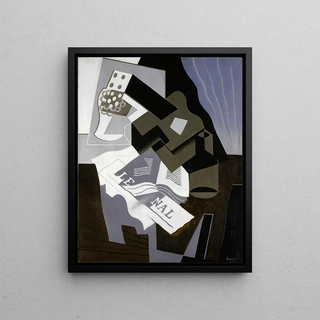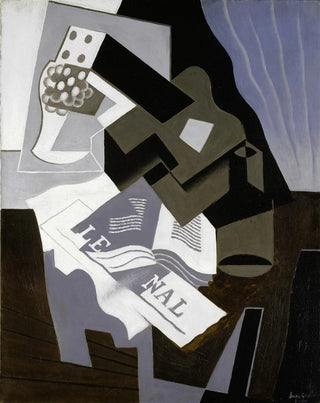Art print | Guitar book and journal - Juan Gris


View from behind

Frame (optional)
"Guitar Book and Journal" by Juan Gris is an iconic piece of the Cubist movement, transcending simple geometric forms to explore the depths of the human mind through a harmonious composition. Created in 1913, this artwork stands out for its innovative approach to the subject, blending elements of everyday reality with a unique artistic interpretation. Gazing at this piece, the viewer is invited to enter a universe where objects come to life, where the guitar and journal become symbols of a particular era, culture, and personal introspection. Light, shadows, and colors intertwine to create an atmosphere that is both intimate and universal, showcasing Gris's technical mastery.
Style and uniqueness of the work
Juan Gris's style is characterized by formal rigor and a carefully chosen color palette. In "Guitar Book and Journal," the artist plays with perspectives and planes to give an impression of depth while maintaining visual clarity. The forms are broken down and reassembled, offering the viewer multiple viewpoints. This artwork does not merely depict objects; it transforms them into a sensory experience. The guitar, a quintessential musical instrument, evokes melody and creativity, while the journal, a voice of thoughts and ideas, symbolizes the quest for knowledge. Gris manages to fuse these elements with such ease that the viewer is immersed in a reflection on art, life, and human interaction.
The artist and his influence
Juan Gris, born in Spain in 1887, quickly established himself as one of the major figures of Cubism alongside Pablo Picasso and Georges Braque. His distinctive approach, marked by intellectual rigor and poetic sensitivity, left an indelible mark on the artistic landscape of the 20th century. By incorporating elements of popular culture and exploring themes such as music and literature, Gris paved the way for a new understanding of modern art. His influence is still felt today, both in painting and in other artistic disciplines. By redefining the boundaries of representation, he encouraged

Matte finish

View from behind

Frame (optional)
"Guitar Book and Journal" by Juan Gris is an iconic piece of the Cubist movement, transcending simple geometric forms to explore the depths of the human mind through a harmonious composition. Created in 1913, this artwork stands out for its innovative approach to the subject, blending elements of everyday reality with a unique artistic interpretation. Gazing at this piece, the viewer is invited to enter a universe where objects come to life, where the guitar and journal become symbols of a particular era, culture, and personal introspection. Light, shadows, and colors intertwine to create an atmosphere that is both intimate and universal, showcasing Gris's technical mastery.
Style and uniqueness of the work
Juan Gris's style is characterized by formal rigor and a carefully chosen color palette. In "Guitar Book and Journal," the artist plays with perspectives and planes to give an impression of depth while maintaining visual clarity. The forms are broken down and reassembled, offering the viewer multiple viewpoints. This artwork does not merely depict objects; it transforms them into a sensory experience. The guitar, a quintessential musical instrument, evokes melody and creativity, while the journal, a voice of thoughts and ideas, symbolizes the quest for knowledge. Gris manages to fuse these elements with such ease that the viewer is immersed in a reflection on art, life, and human interaction.
The artist and his influence
Juan Gris, born in Spain in 1887, quickly established himself as one of the major figures of Cubism alongside Pablo Picasso and Georges Braque. His distinctive approach, marked by intellectual rigor and poetic sensitivity, left an indelible mark on the artistic landscape of the 20th century. By incorporating elements of popular culture and exploring themes such as music and literature, Gris paved the way for a new understanding of modern art. His influence is still felt today, both in painting and in other artistic disciplines. By redefining the boundaries of representation, he encouraged






